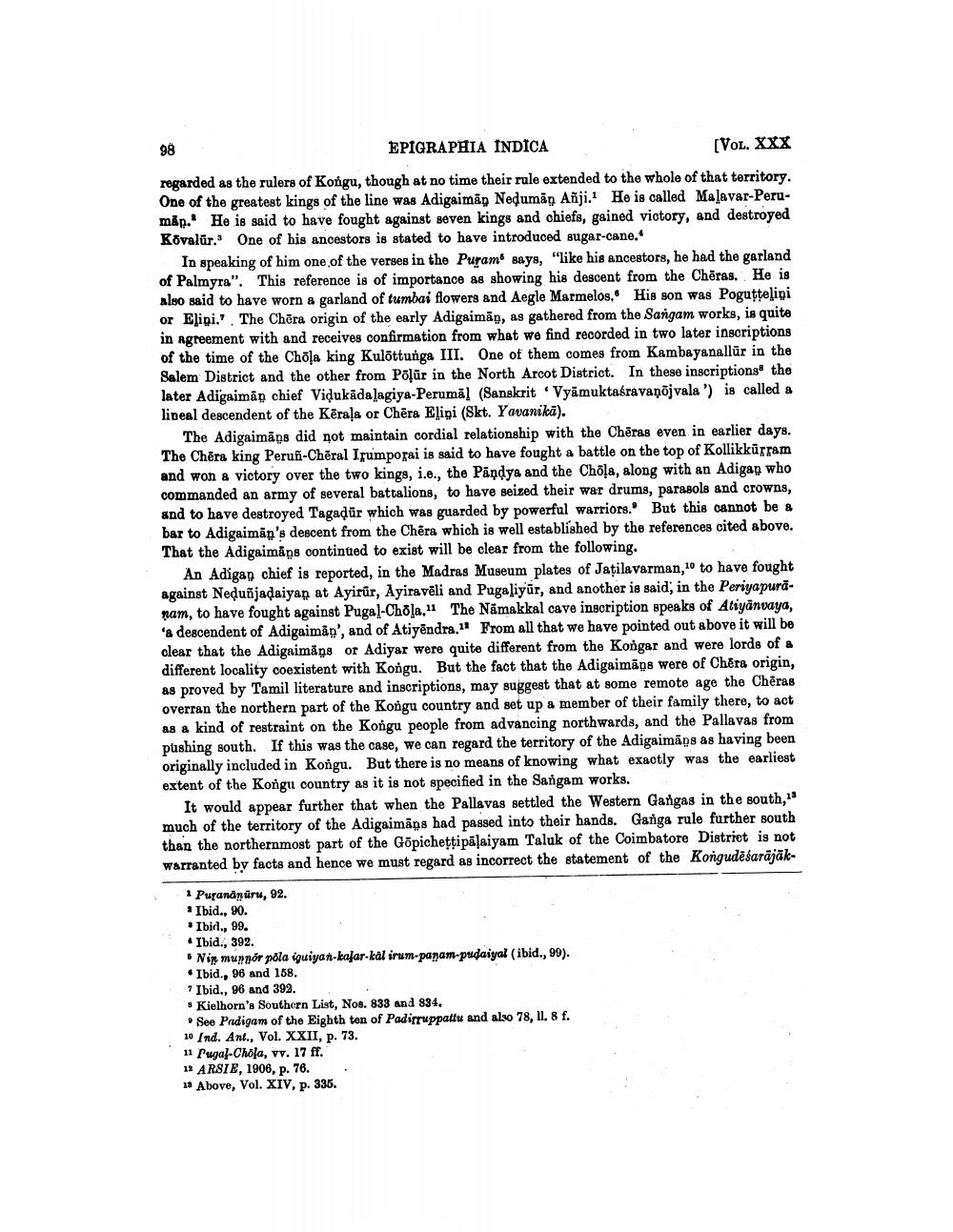________________
98
EPIGRAPHIA INDICA
[VOL. XXX
regarded as the rulers of Kongu, though at no time their rule extended to the whole of that territory. One of the greatest kings of the line was Adigaimán Nedumān Añji. He is called Malavar-Perumåp. He is said to have fought against seven kings and chiefs, gained viotory, and destroyed Kovalür. One of his ancestors is stated to have introduced sugar-cane.
In speaking of him one of the verses in the Puram says, "like his ancestors, he had the garland of Palmyra". This reference is of importance as showing his descent from the Chēras. He is also said to have worn & garland of tumbai flowers and Aegle Marmelos. His son was Poguttelini or Eligi.'. The Chēra origin of the early Adigaimān, as gathered from the Sangam works, is quite in Agreement with and receives confirmation from what we find recorded in two later inscriptions of the time of the Chola king Kulõttunga III. One of them comes from Kambayanallūr in the Salem District and the other from Pēļūr in the North Arcot District. In these inscriptiong the later Adigaimap chief Vidukādalagiya-Perumal (Sanskrit Vyāmuktaśravaņājvala') is called a lineal descendent of the Kēraļa or Chēra Elini (Skt. Yavanikä).
The Adigaimáns did not maintain cordial relationship with the Chēras even in earlier days. The Chēra king Peruñ-Chēral Igumporai is said to have fought a battle on the top of Kollikkūrfam and won a victory over the two kings, i.e., the Pandya and the Chõļa, along with an Adigan who commanded an army of several battalions, to have seized their war drums, parasols and crowns, and to have destroyed Tagadūr which was guarded by powerful warriors. But this cannot be & bar to Adigaimān's descent from the Chēra which is well established by the references cited above. That the Adigaimans continued to exist will be clear from the following.
An Adigan chief is reported, in the Madras Museum plates of Jațilavarmanto have fought against Neduñjadaiyan at Ayirür, Ayiravēli and Pagaliyūr, and another is said, in the Periyapuranam, to have fought against Pugal-Chola." The Namakkal cave inscription speaks of Atiyānvaya, '& descendent of Adigaimap', and of Atiyêndra. From all that we have pointed out above it will be clear that the Adigaimans or Adiyar were quite different from the Kongar and were lords of a different locality coexistent with Kongu. But the fact that the Adigaimāns were of Chēra origin, as proved by Tamil literature and inscriptions, may suggest that at some remote age the Cheras overran the northern part of the Kongu country and set up a member of their family there, to act as a kind of restraint on the Kongu people from advancing northwards, and the Pallavas from pushing south. If this was the case, we can regard the territory of the Adigaimāps as having been originally included in Kongu. But there is no means of knowing what exactly was the earliest extent of the Kongu country as it is not specified in the Sangam works.
It would appear further that when the Pallavas settled the Western Gangas in the south, much of the territory of the Adigaimaps had passed into their hands. Ganga rule further south than the northernmost part of the Gopichettipālaiyam Taluk of the Coimbatore District is not warranted by facts and hence we must regard as incorrect the statement of the Kongudēšarājāk
1 Purandūru, 92. * Ibid., 90. . Ibid., 99.
Ibid., 392. . Ning murnór pôla iguiyan-kalar-kal irum-panam-pudaiyal (ibid., 99). • Ibid., 06 and 158.
Ibid., 96 and 392. • Kielhorn's Southern List, Nos. 833 and 934, .See Padigan of the Eighth ten of Padirruppattu and also 78, 11. 8 f. 10 Ind. Ant., Vol. XXII, p. 73. 11 Pugal-Choja, vv. 17 ff. 12 ARSIE, 1906, p. 76. 13 Above, Vol. XIV, p. 335.




